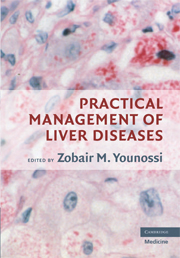Book contents
- Frontmatter
- Contents
- Preface
- Contributors
- 1 Acute Viral Hepatitis
- 2 Chronic Hepatitis B and D
- 3 Chronic Hepatitis C
- 4 HIV and Viral Hepatitis
- 5 Nonalcoholic Fatty Liver Disease
- 6 Alcoholic Liver Disease
- 7 Genetic Hemochromatosis and Iron Overload
- 8 Wilson's Disease
- 9 Alpha-1 Antitrypsin Deficiency and the Liver
- 10 Autoimmune Liver Disease
- 11 Drug-Induced Liver Disease (DILI)
- 12 Benign and Malignant Tumors of the Liver
- 13 Complications of Cirrhosis
- 14 Liver Transplantation
- 15 Novel Technologies in Studying Chronic Liver Disease
- Index
- References
2 - Chronic Hepatitis B and D
Published online by Cambridge University Press: 08 August 2009
- Frontmatter
- Contents
- Preface
- Contributors
- 1 Acute Viral Hepatitis
- 2 Chronic Hepatitis B and D
- 3 Chronic Hepatitis C
- 4 HIV and Viral Hepatitis
- 5 Nonalcoholic Fatty Liver Disease
- 6 Alcoholic Liver Disease
- 7 Genetic Hemochromatosis and Iron Overload
- 8 Wilson's Disease
- 9 Alpha-1 Antitrypsin Deficiency and the Liver
- 10 Autoimmune Liver Disease
- 11 Drug-Induced Liver Disease (DILI)
- 12 Benign and Malignant Tumors of the Liver
- 13 Complications of Cirrhosis
- 14 Liver Transplantation
- 15 Novel Technologies in Studying Chronic Liver Disease
- Index
- References
Summary
BACKGROUND
Despite the widespread application of vaccination programs, chronic hepatitis B virus (HBV) infection remains a significant public health problem with 350–400 million people infected worldwide. The prevalence of chronic HBV infection displays a significant geographic variation with areas of high (8–15%), intermediate (1–7%), and low (<1%) endemicity.
Differences in the prevalence and incidence rates of HBV infection are largely linked to different modes and age of HBV transmission as well as with socioeconomic factors. In areas of high HBV endemicity such as the East Asia and sub-Saharan Africa, transmission occurs mainly during the perinatal or during the early childhood period. On the other end, in industrialized countries of North Europe, Australia, and North America where the endemicity is very low (<1%), HBV is transmitted mainly in high-risk adult populations through injection drug use, high-risk sexual behavior, and occupation-related needlesticks (health care workers). However, even in these populations perinatal and early childhood transmission still accounts for the majority of chronic HBV infections.
PATHOGENESIS
The transition of an acute to a chronic HBV infection is mainly influenced by the age of the host at which exposure to the virus occurs. During the perinatal and early childhood period (< 5 years), the majority of infections lead to chronicity. So far, it is unclear what are the exact immune mechanisms that contribute to the inability of the host to eradicate the virus. A role of the secreted HBe protein as a potential tolerogen during the neonatal period has been suggested.
- Type
- Chapter
- Information
- Practical Management of Liver Diseases , pp. 26 - 38Publisher: Cambridge University PressPrint publication year: 2008
References
- 1
- Cited by



